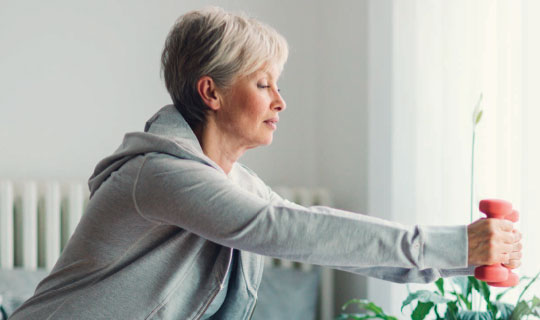
Simple ways to stay fit when the weather is frightful.
With winter comes the temptation to curl up on your couch till the spring thaw. But fight the urge for the sake of your health, advises Ryan Stevens, MPS, ATC, CSCS, Manager of Athletic Training Services at Robert Wood Johnson University Hospital (RWJUH) Hamilton. “Winter workouts have many physical and emotional benefits,” he says.
For starters, staying active charges up your immunity: A few minutes of daily exercise can help keep colds and the flu at bay. In addition, winter workouts can help you avoid the five- to 10-pound weight gain that is typical during the season. Exercise outside and you may burn a few more calories than you would inside, depending on how hard your body has to work to stay warm. In addition, you may get a small dose of sunlight, which can boost your vitamin D intake and lift your spirits. “It can be tough to be inside all winter if you like to be outside,” says Stevens. “So forcing yourself to go outside—even for short periods of time—can improve your mood.” What’s more, research shows that exercise fends off depression. Experts don’t know exactly why, but it releases endorphins (chemicals that leave you with a sense of well-being) and increases blood flow to the brain.
Simple indoor exercises
When the weather is frightful, you may be forced to bring your workout inside. Here are some simple exercises that can be done as warm-ups (for 15 seconds each) or for longer periods (30 to 45 seconds each). Do all of them two or three times to increase your endurance, says Ryan Stevens, MPS, ATC, CSCS, Manager of Athletic Training Services at Robert Wood Johnson University Hospital (RWJUH) Hamilton. “If you aren’t comfortable getting on the floor, try these exercises on your bed,” he suggests.
- Three-Point Stability: Starting in a push-up position (also called a “high plank”), alternate taking one foot off the ground, then repeat with one hand off the ground. If it’s too difficult to get down on the floor, this exercise can be performed by leaning against a countertop.
- Bridges: Lie on your back with your knees flexed and your feet under your knees. Lift your hips in the air, pressing through your heels. If you’re able, alternate marching your legs up and down while you perform this exercise.
- Hamstring Pumps: Lie on your back with both knees straight. Grab one of your thighs and pull it up toward your chest. Extend the knee of the leg you are holding into the air as high as you can, pumping it up and down. Do this for 15 seconds, then switch sides.
- Reach & Rotate: Get on all fours. Starting with your right hand, reach underneath and across your body to the left as far as you can. Then rotate back to the right and reach toward the ceiling. Lead with your thumb, as though you’re hitchhiking.
- Squats: Standing in one place, pretend you’re sitting down into a chair, and then stand up tall again. Keep your feet parallel and flat on the ground.
- Hinges: Standing up with your knees slightly bent, bend forward at your hips while keeping your back straight like a tabletop . Straighten back up again.
Cold weather safety
While there are many benefits to working out during the winter months, keep the following in mind before you hit the pavement (or slopes):
- Choose footwear with a good grip to avoid slipping and falling in the ice and snow.
- Wear a fleece or wool hat and mittens. This can help you avoid frostbite (freezing of the skin and other tissues).
- Dress in layers. Your first layer should be a synthetic fabric designed to wick away sweat. The second should be wool or fleece. Top it off with a breathable and waterproof layer. You can always remove it if you feel too warm.
- Slather on sunscreen (with an SPF of 30 or above) and wear sunglasses. Ice and snow reflect the sun’s ultraviolet rays.
- Drink plenty of water to avoid dehydration.
- Beware of frostbite in the bitter cold. Watch for numbness, a lack of color and tingling in your ears, nose, hands and toes. If you notice any of these symptoms, head indoors immediately and warm your skin slowly. Don’t assume it takes a long time for frostbite to set in—it can happen in as little as 30 minutes if it’s 0 degrees Fahrenheit and the wind speed is 15 mph.
Feeling the burn
Wonder what the fitness payoff is for outdoor activities? Here’s how many calories you’ll burn in 30 minutes*:
- Brisk walking at 4 miles per hour: 167
- Running at 5 miles per hour: 298
- Hiking: 223
- Downhill skiing: 223
- Cross-country skiing: 298
- Snowshoeing: 298
- Ice-skating: 260
- Operating a snowblower: 167
- Shoveling snow by hand: 223
* Based on a 155-pound person
Exercise with us this winter! To learn more about RWJ Fitness & Wellness in Quakerbridge click here.